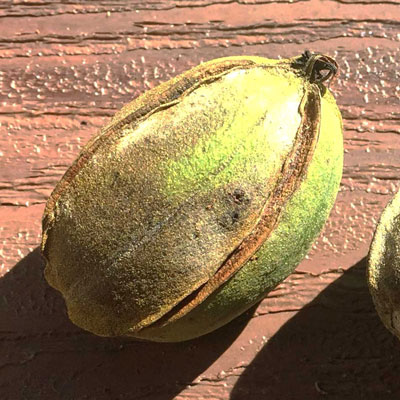Pecan Scab Season Has Arrived

Our sunroom is situated (like most of our house) beneath giant pecan trees. And our sunroom has two very large glass skylights. When pecans start falling out of the trees, we are vitally aware.
One would expect that to be in late October and especially November, but not these pecans. They start dropping pecans by mid-summer, and they drop all the way into the spring.
The late droppers that hang on the trees much longer than they should have, in many cases, been ruined by hickory shuckworms that have tunneled out the shucks and kept the kernels from filling out. They hang up in the trees until winter winds, ice and just plain old age cause them to fall.

But the ones that fall early are a different story entirely. They’re what we’re beginning to see right now. They’ve been smitten with a fungal disease known as pecan scab. That disease attacks the pecans earlier in the summer, especially following cool, moist springs.
Symptoms of pecan scab are the black husks and the very premature drop while the kernels are still watery and completely immature. They soon turn black as well and the entire pecan is rendered unfit for consumption, even by squirrels and crows.
Some varieties of pecans are highly susceptible to pecan scab. For that reason, in spite of their very high quality, they should only be planted in the more arid parts of West Texas. Western and Wichita are examples.
Other varieties are known to be more resistant to the disease and are better selections if you’re gardening in East Texas where humidities are generally higher. Caddo is always on that list, as is Desirable.
With native pecan seedlings like we have in the Sperry pecan forest, you have no way of knowing each plant’s genetics so you’re really taking your chances, and we’ve had the misfortune of positioning our skylights beneath two trees that are obviously rather susceptible.

Nurseries and farm stores usually have fungicides labeled for controlling diseases on pecan trees. The bigger issue may be in finding a sprayer powerful enough to deliver the fungicide to the tops of large trees. You will need to spray several times from late spring through the summer, dependent on the frequency of rainfall.
This may sound like giving in to the beast, but there are some of us who merely choose to harvest the pecans that mature normally – those that survive the pecan casebearers, pecan scab, pecan weevils, and hickory shuckworms, among other problems. Oh, and those that haven’t been pilfered by squirrels.
In good years there are plenty to share. In poor years, it’s not worth all the angst of homeowner spraying – at least, that’s what I’ve decided.
I’ll let you choose for yourself.
Here are two good publications done by pecan specialists with Texas A&M and the Texas A&M AgriLife Extension.
On native pecans: https://aggie-horticulture.tamu.edu/fruit-nut/wp-content/uploads/sites/6/2015/04/pecans_native_2015.pdf
And on “improved” varieties: https://aggie-horticulture.tamu.edu/fruit-nut/wp-content/uploads/sites/6/2015/04/pecans_improved_2015.pdf
